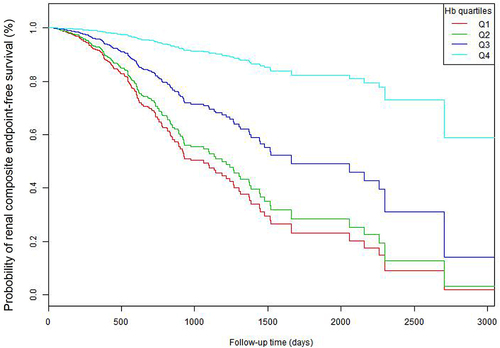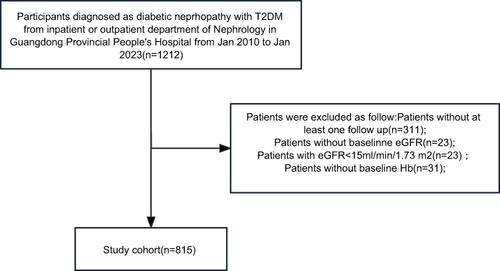Figures & data
Table 1 Baseline Characteristics of All the Patients at Enrollment (n=815)
Figure 2 Showed the distribution of Hb levels. It showed a normal distribution within a range from 56g/L to 187g/L (with an average of 121.5g/L).

Table 2 Incident Rate of Renal Composite Endpoint
Figure 3 The distribution of different eGFR levels and 24hU-alb severity levels with different hemoglobin levels. (A) The relationship between eGFR and Hb in male DKD patients. (B) The relationship between eGFR and Hb in female DKD patients. (C) The relationship between 24hU-alb and Hb in male DKD patients. (D) The relationship between 24hU-alb and Hb in female DKD patients.

Figure 4 Incidence of renal composite endpoint according to Hb quartiles. This figure showed that participants within the highest Hb group had lower incidence rate of renal composite endpoint compared to the group with the lowest Hb (p < 0.0001 for trend).

Table 3 The Results of Univariate Analysis of Renal Composite Endpoint
Figure 5 Kaplan–Meier survival curve. The probability of renal composite endpoint-free survival differed significantly between the Hb quartiles (Log rank test, p < 0.001). The probability of renal composite endpoint-free survival gradually decreased with decreasing Hb, suggesting that the group with the highest Hb had the highest probability of renal composite endpoint-free survival.

Table 4 Relationship Between Hb and Renal Composite Events in Different Models
Table 5 The Results of Two-Piecewise Regression Linear Model
Figure 6 The non-linear relationship between Hb and the renal composite endpoint among DKD patients. We used a Cox proportional hazards regression model with cubic spline functions to evaluate the relationship between Hb and renal composite endpoint. The result showed that the relationship between Hb and renal composite endpoint was non-linear, with the inflection point of Hb being 109g/L.

Table 6 Results of Subgroup Analysis and Interaction Analysis
Data Sharing Statement
The original contributions presented in the study are included in the article/Figures Material. Further inquiries can be directed to the corresponding author.

